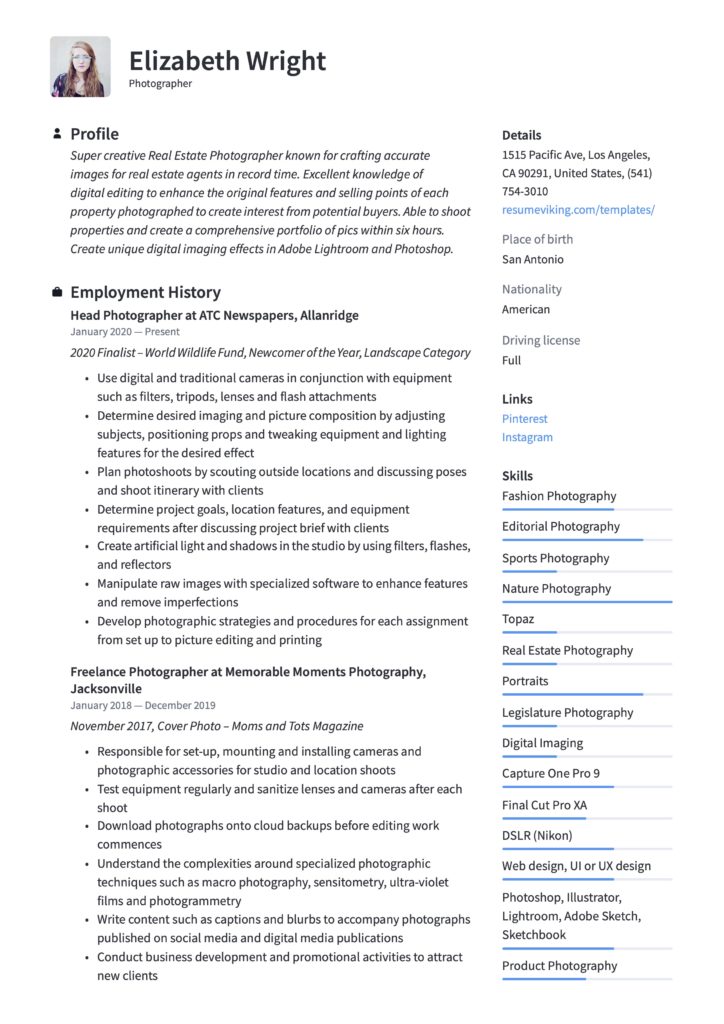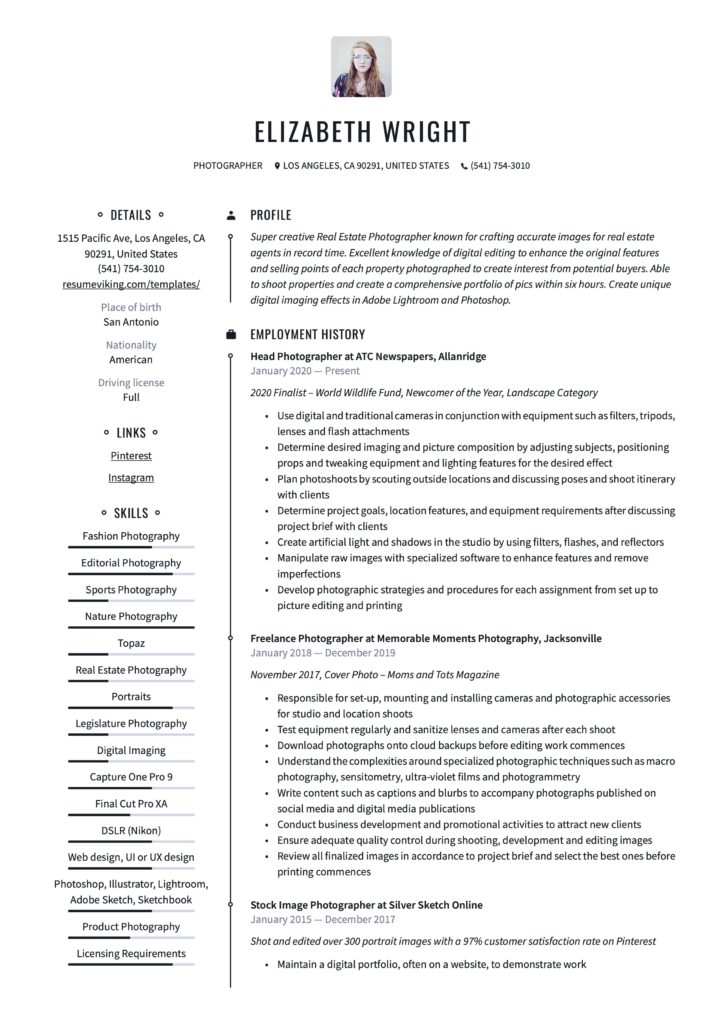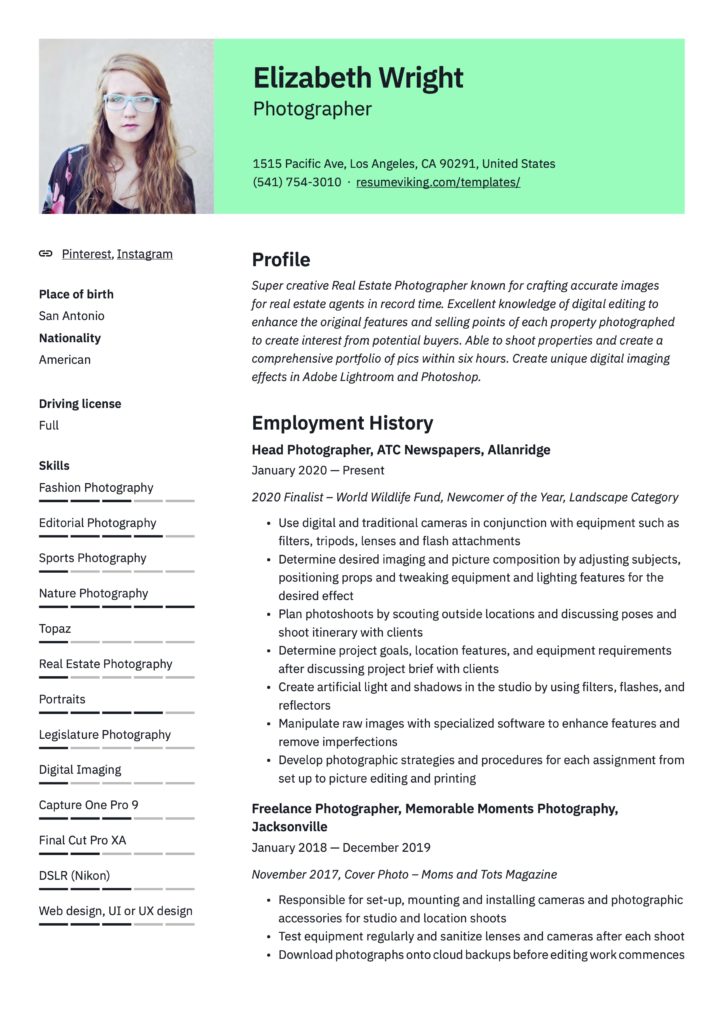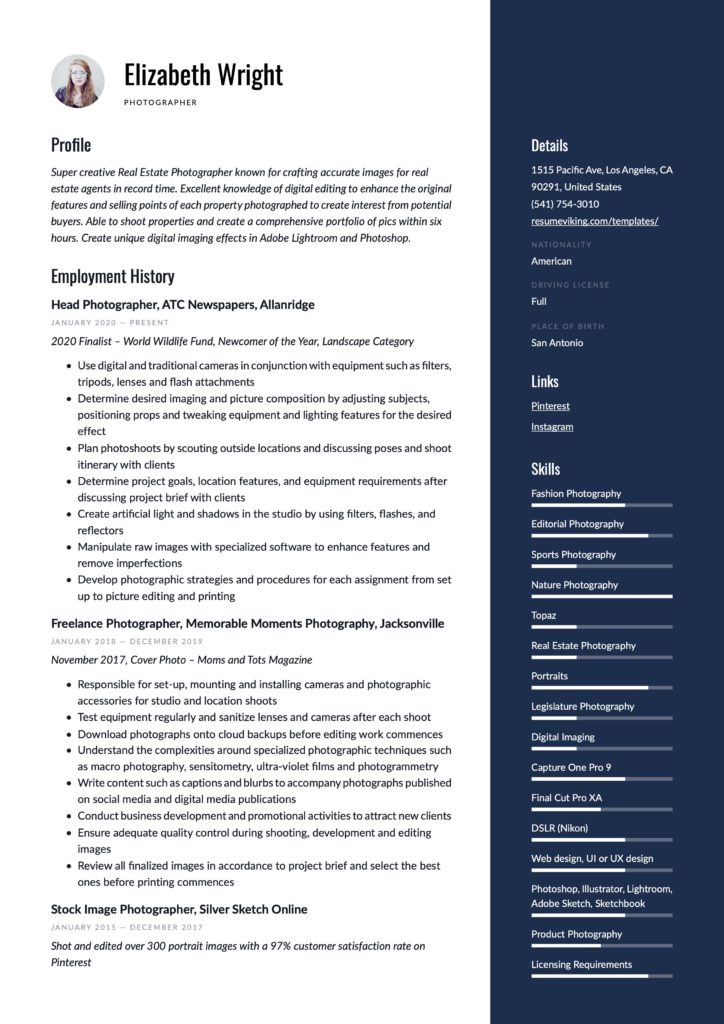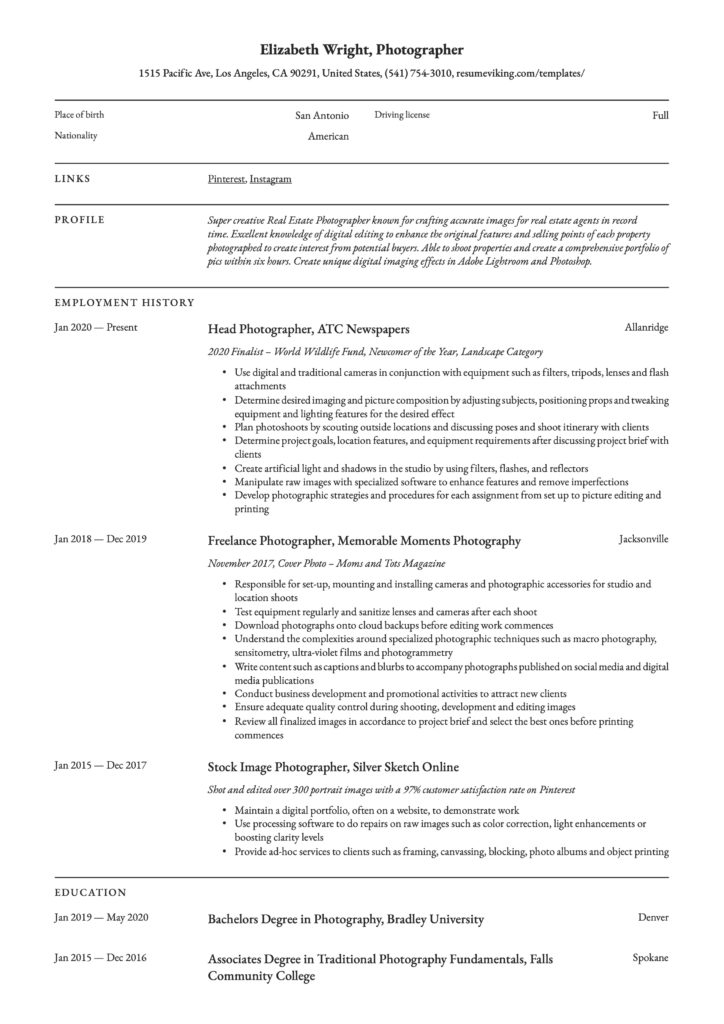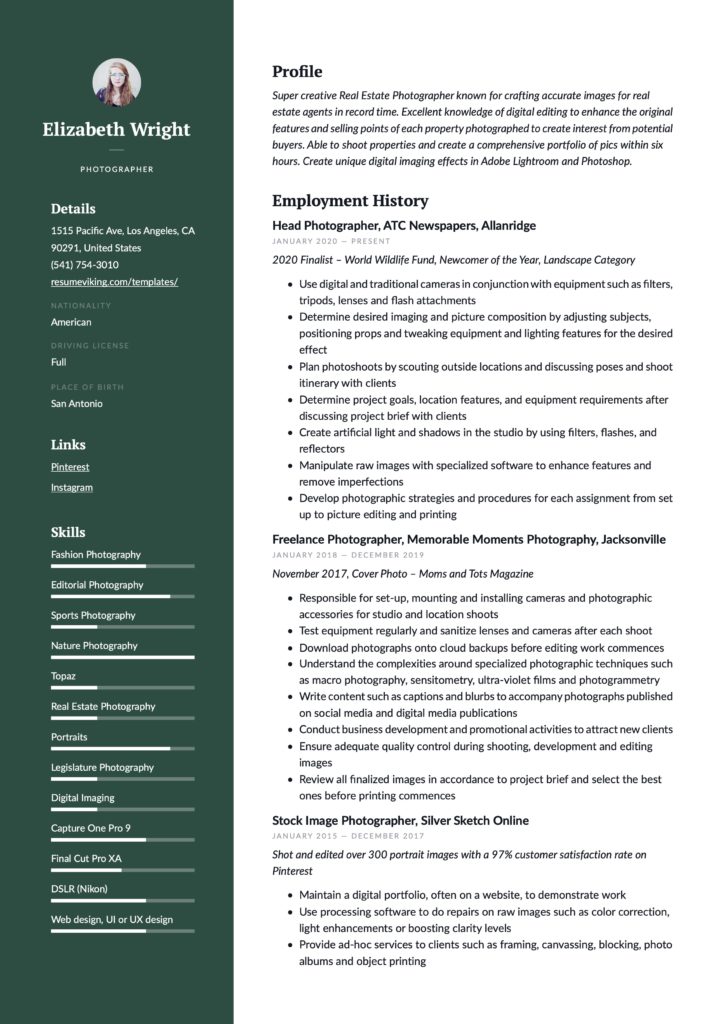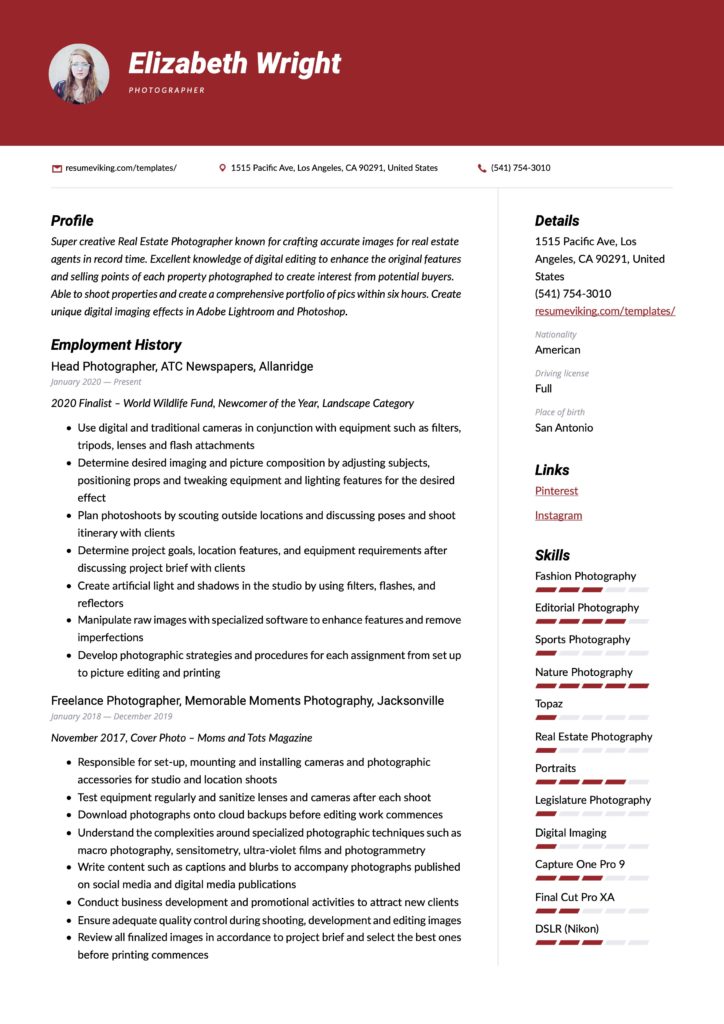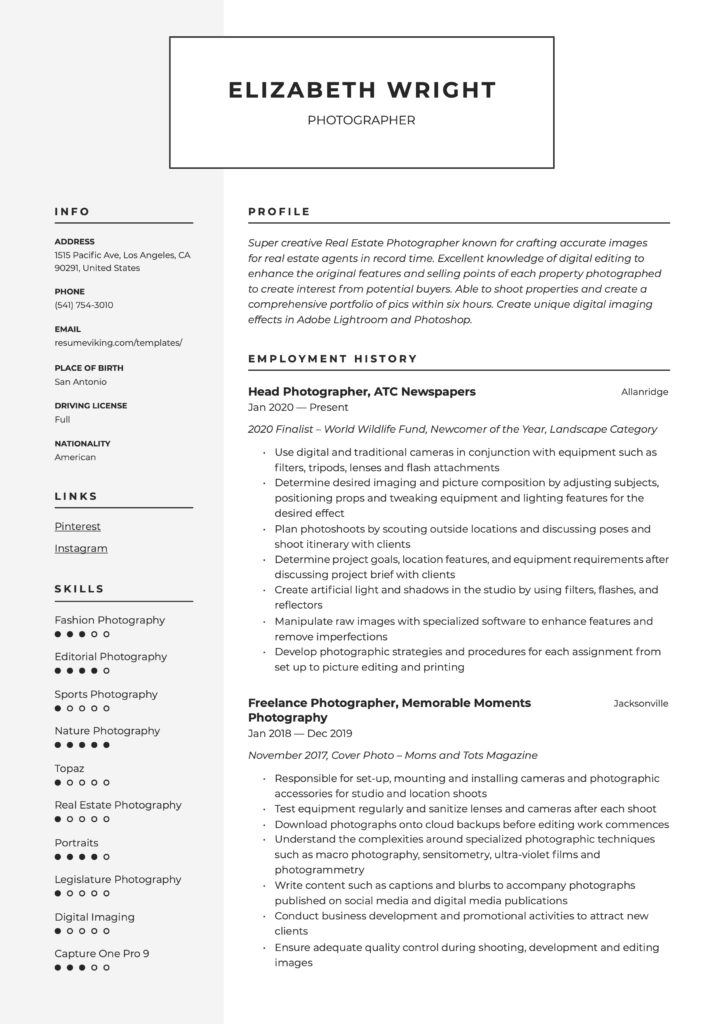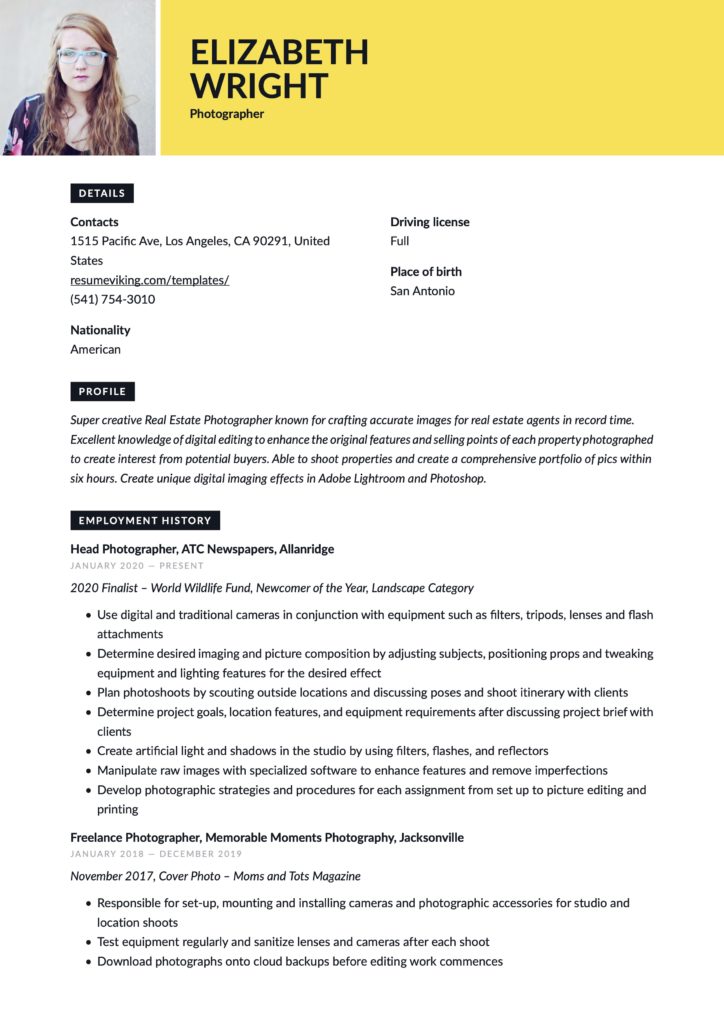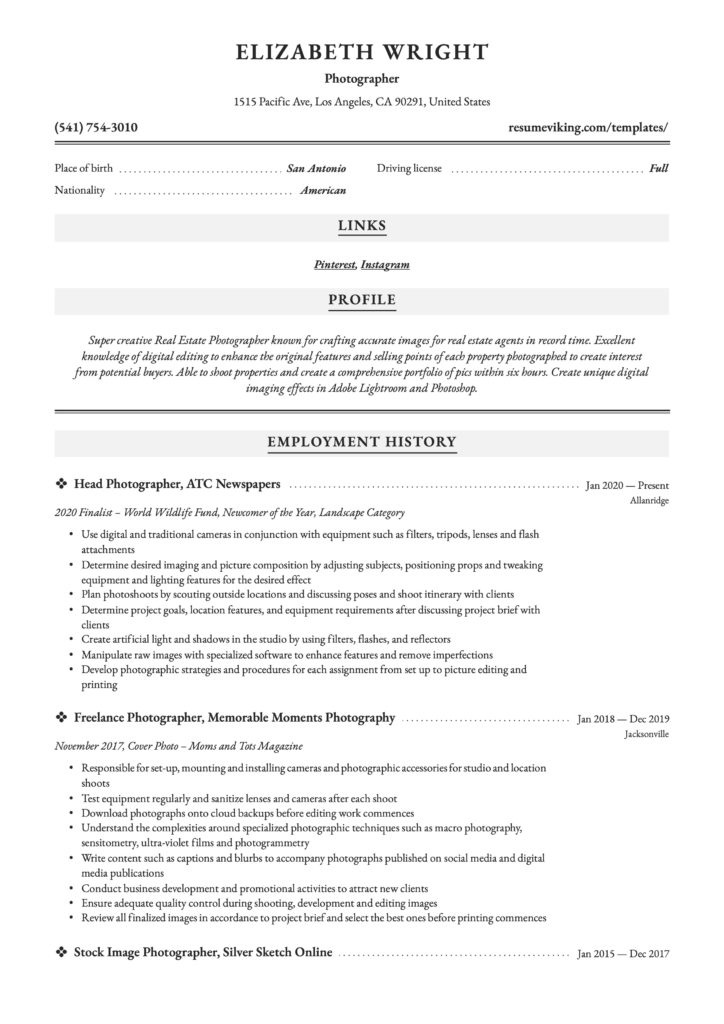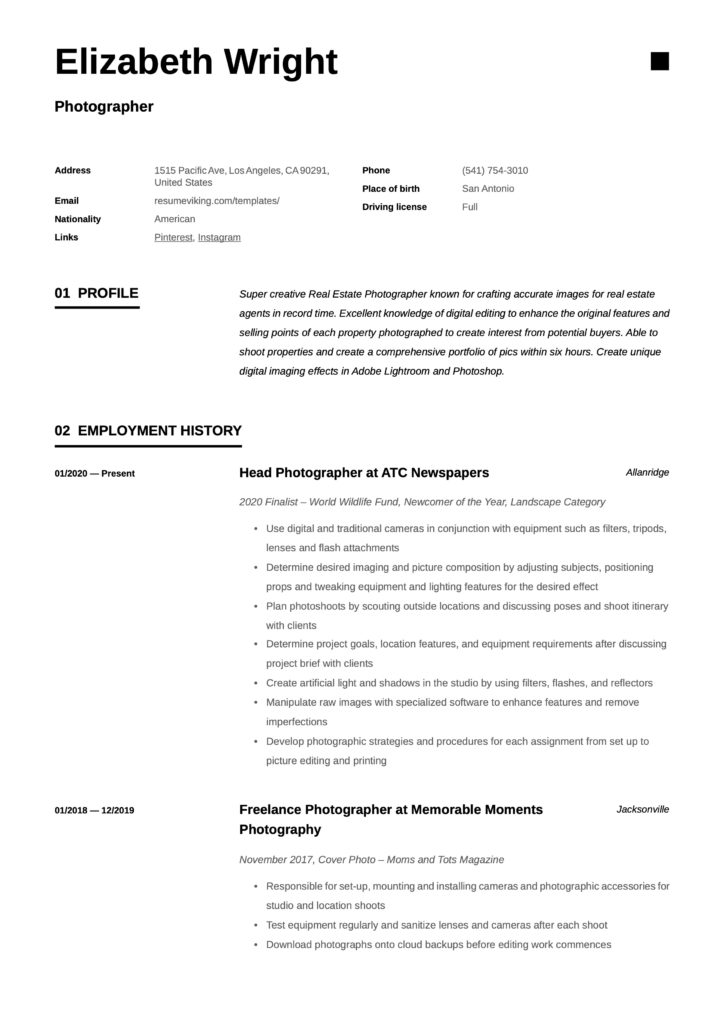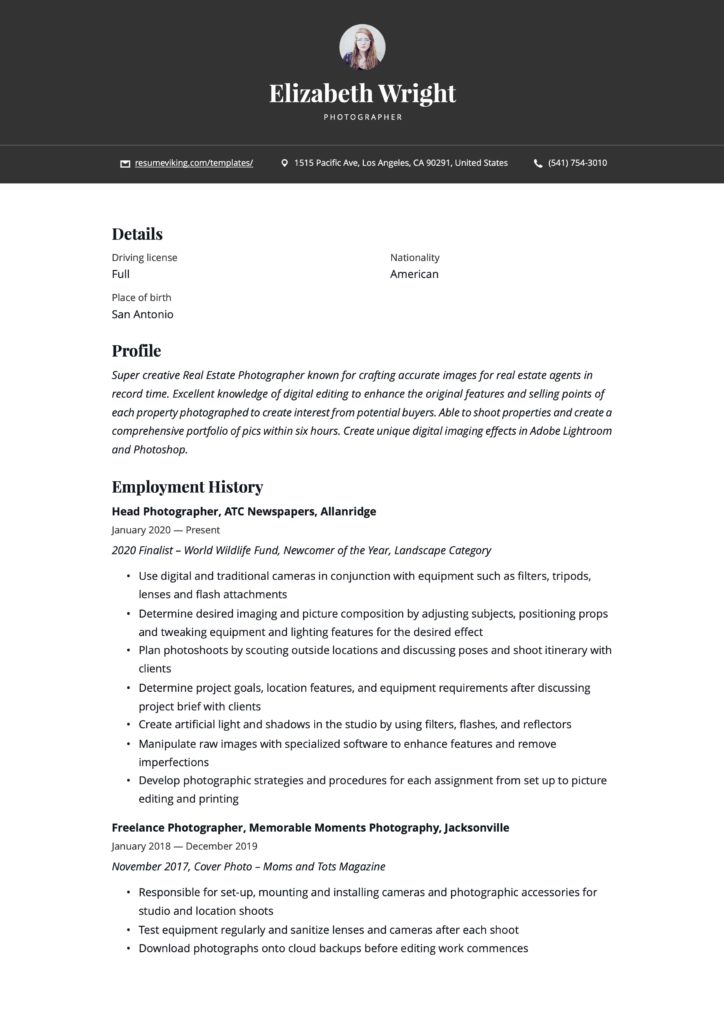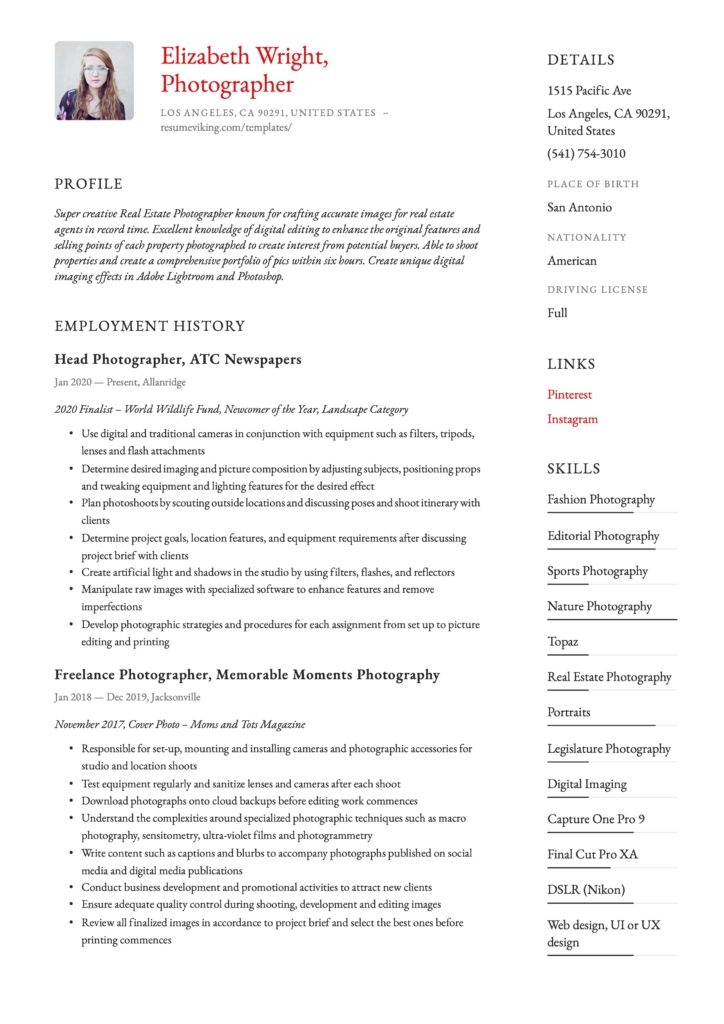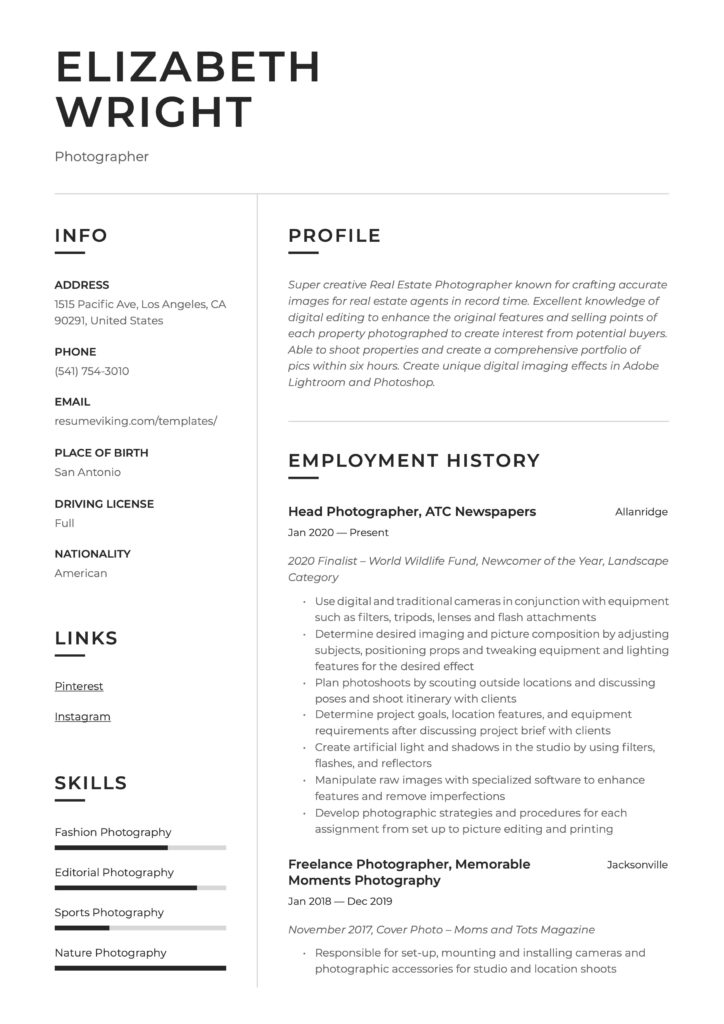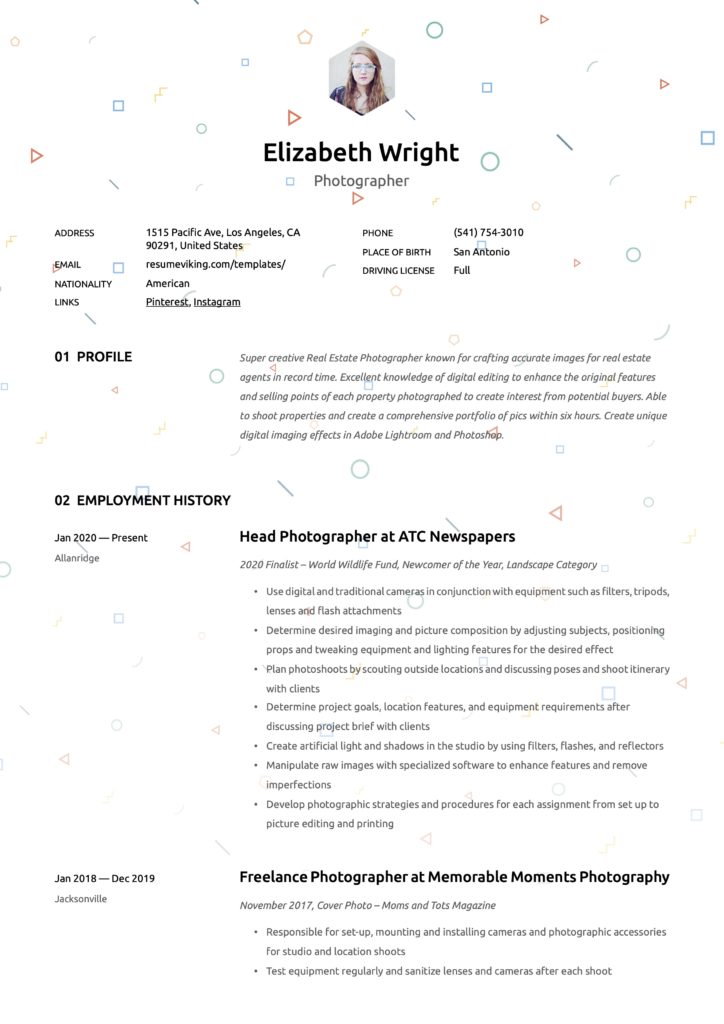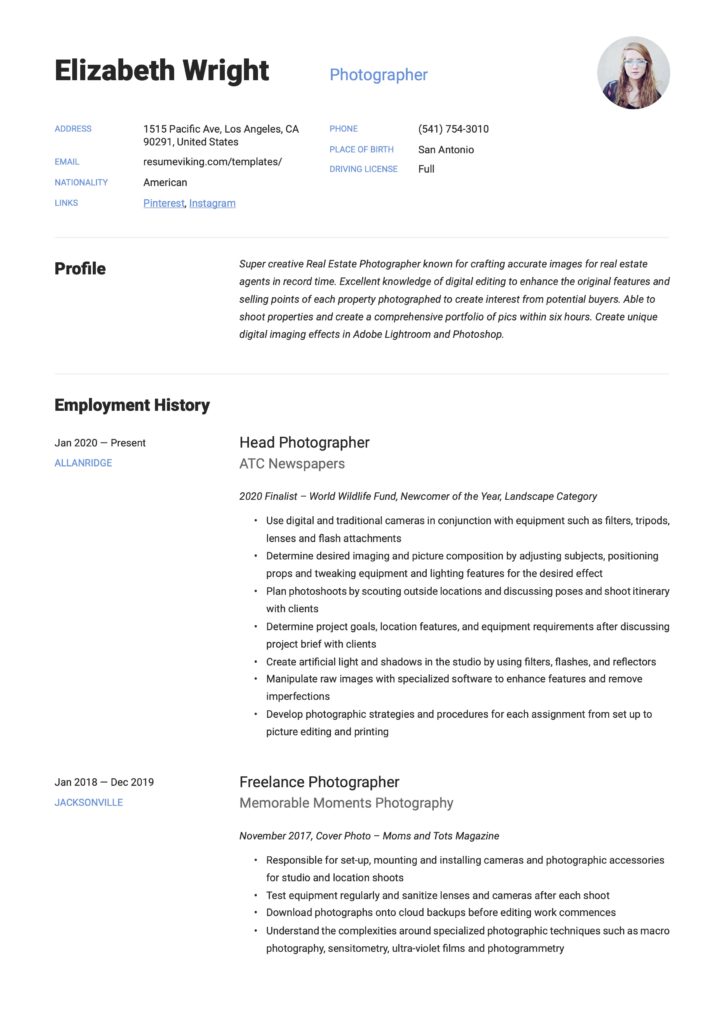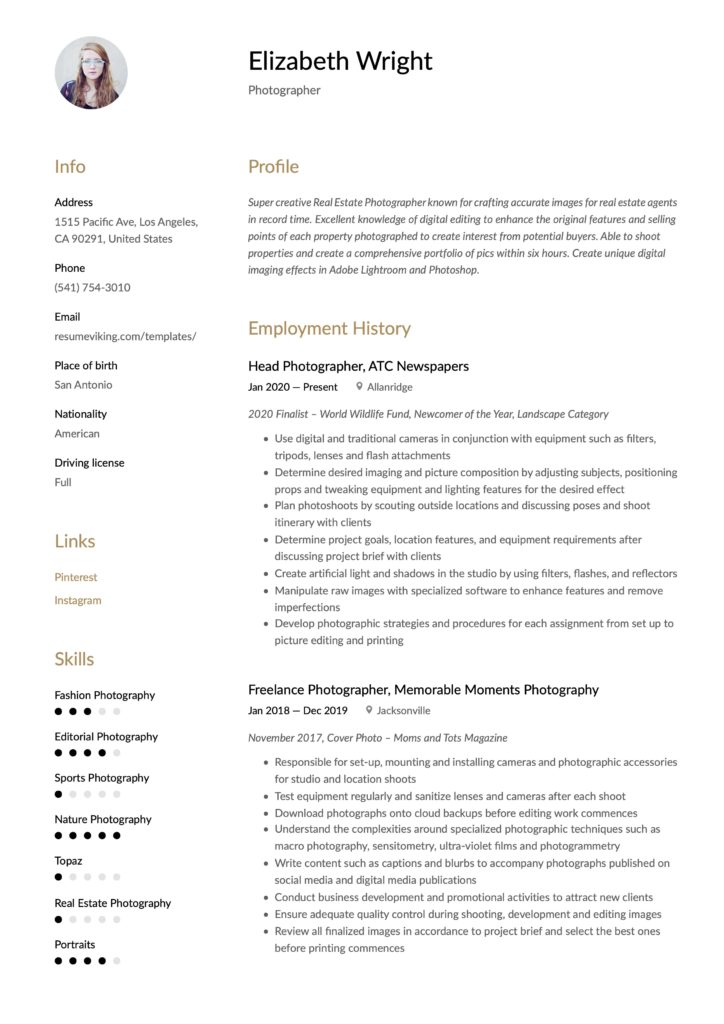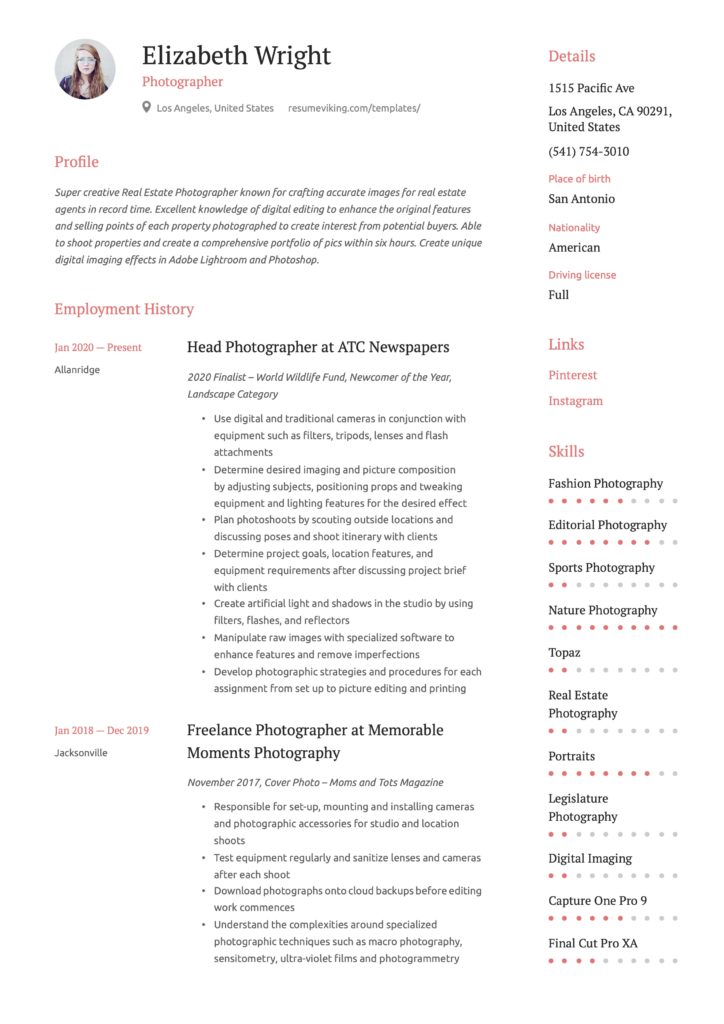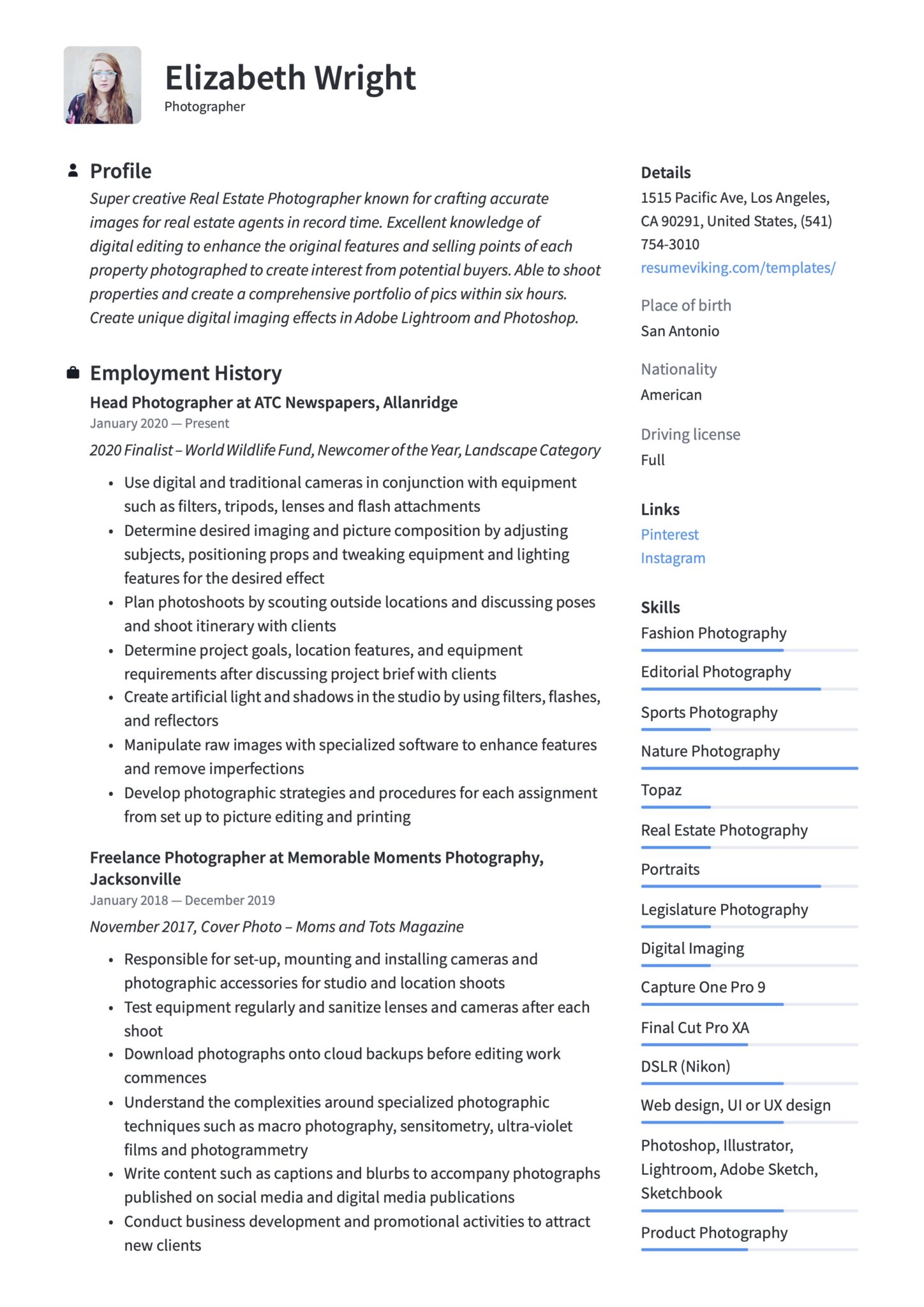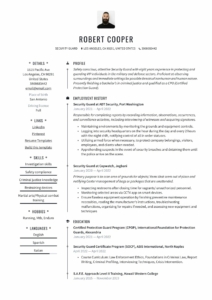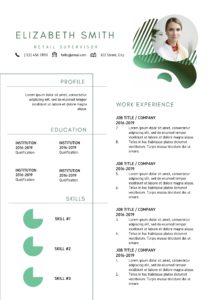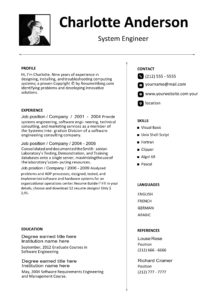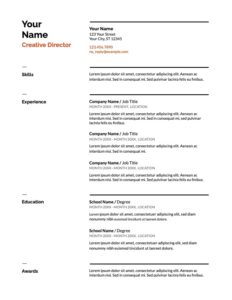When you are on the hunt for a new Photographer gig, it would be a smart move to check out a top-notch Photographer resume sample. Our write-up below is filled to the brim with step-by-step instructions to walk you through the resume editing process.
You are probably an expert on taking the perfect shots. We are experts in providing you with a shot at landing the ideal photography job. The information in this guideline will assist you in discovering what your unique suite of photography skills are, how to highlight your competencies, and also advice on writing killer accomplishment statements and informative career summaries.
If you expect dollar signs when people say cheese, your resume application should focus on the value offering that prospective employers or clients may expect when they hire you.
What you can read in this article
23 Photographer Resume Examples
(Free resume sample downloads, pdf's, are at the bottom of this page)
The Photographer Resume Guide
Resume Sections
1. Contact Information:
- Name
- Address
- Phone
Add alternative contact channels like your LinkedIn profile, Instagram, or Facebook URL details. As an optional extra included, your portfolio or website URL too, if applicable.
2. Career Summary:
The career synopsis is the one chance you have to make an impression and ensure that the rest of your resume document receives the attention it deserves. Focus on your specialist skills, type of photography, and value-adding strengths. A career summary should be no longer than 3-6 sentences, to be read in its entirety by the recruiter in a few seconds.
3. Qualifications Summary:
Formal education is not a necessity to land a position as a photographer, but pure talent can only get you so far. Training is imperative to perfect your craft, and the tendency these days is to participate in training programs, formally study photography as a subject discipline and take practical classes in specific areas of photography such as equipment, shot composition, editing, and design. List the most recent credentials first, by name, institution attended, and dates completed.
4. Relevant Photography Experience:
Explain and present your employment history in reverse chronological order and add hyperlinks to this section that points to examples of your best work. Give no more than five bullet points per each role and keep the sentences informative but concise.
5. Other Employment Experience:
Freelance photography work as a hobby or gig on the side should be reflected in your resume, even if you were not officially employed or paid for those projects. You can mention projects like taking pictures at the university sports day, at a friend's wedding, or on a charity drive as a volunteer. Provide examples of publications and the dates that your pics were published.
6. Skills Summary/Key Skills:
Without proof, your skills don't mean much, so be as specific as you can when compiling your skills section. Instead of writing that you can use state of the are equipment, instead, mention the exact make and model of the devices you are familiar with. A smart move is to read through the advertisement or project brief a few times and identify the client's needs. Then tailor your skills section to address those needs with compelling competencies and core technical traits related to your trade.
What to Highlight in a Photographer Resume
Your resume should leave recruiters and hiring managers wanting to “see” more of you, in the shape of an interview. As a photographer, you are expected to be competent at using high-end camera equipment, understand shot composition, and be familiar with editing and design. However, there are specific points that potential clients or employers would look for in your photographer's resume to decide whether you are a fit for the job.
A photographer generally works in a freelance capacity on multiple projects simultaneously. If this resembles your current work approach, then be specific of the segments you can “shoot” in, for example, wedding ceremonies, graduation events, or corporate work such as business websites, promotional materials, or live events. You may also have more of a focus on artistic photography where the decision of what to shoot lies with you, and clients may buy your pictures online.
A photographer may also be employed full time at digital or print newspapers, movie production houses, or even government. Explain which kinds of photography you specialize in, for example, stills for motion pictures, photojournalism, or taking photos at crime scenes to be used by local and federal law enforcement agencies. Details are vital here, so make sure to highlight your technical competencies (knowledge of composition, angles, light measurements) and how you would set up your shooting environment in an outside location as well as in a studio environment.
Time to show and tell prospective employers and clients about your digital or physical development skills. Also, digital editing is the assumed competency these days. There has been a shift back to physical editing and shooting raw footage with Polaroids, for example. Be clear about your editing skills. Some clients prefer what is called heavy editing, where you need to know your way around design and editing software, where others are more comfortable with a very light touch on editing expecting the produced picture to be as close as possible to the original photograph taken. Clients would be interested in your editing methodologies from cropping and changing color schemes to changing lighting and adding or removing objects from the original pictures taken.
Then comes the genres that you are familiar with. Photographers starting in their careers often resort to a few genres to build up their reputation, where others will focus on only one particular style. The main categories in terms of photography genres include
Wedding Photography:
In this sector, you need to be an expert at “herding guests,” dealing with bridezillas and also resourceful enough should an impromptu torrential rainstorm ruin the possibilities of a pristine outdoor shoot. A wedding day is typically one of the most critical events in a person's life, and to land the client, you need to showcase your talents of capturing one-time moments with creative, beautifully composed, and storytelling photographs. You will have to prove your skills in time management, communication, ascertaining the vision of the couple, having an empathetic approach, and the ability to make everyone feel comfortable on the day so that the pictures are as natural as possible. Clients would also base a decision to hire you on your ability to deliver finalized images in a few weeks instead of months, so be sure to include your average delivery times in your pitch.
Fashion Photography:
The industry of fashion and design is highly competitive, and prospective employers would look for a photographer with a very creative eye, superb design, and editing skills, and the ability to deliver perfection in a very short space of time. Employers in this industry include fashion houses, clothing designers, advertising agencies, or beauty magazines. You also need a thick skin aka loads of tact and diplomacy. Photographers have to deal with irritated models and annoyed agency managers, hairstylists, fashion stylists, and makeup artists. They will be expecting cues from you during the setup of your scenes as well as the prepping and positioning of models in terms of hair, make-up, and clothing. Mention your subject matter expertise, for example, taking pics of apparel, accessories, or fashion models, and if you are comfortable with full-length or face shoots.
Travel Photography:
In this genre, you should present your competencies at taking images that resemble the culture, people, landscapes, customs, and history of a location as close as possible to the real thing. Travel photography is more challenging to monetize than wedding, fashion, or real estate photography. Where income generation previously came from stock photography royalties or magazine assignments, travel photographers are now also expected to diversify into blogging, tutorials, and creative writing. Your capacity to navigate the world of Instagram, Pinterest, and other social media platforms to create followership and influence ideas would be paramount for potential employers who would want to hire you.
Food Photography:
An apple is not merely an apple when you find yourself in the food photography scene. Yes, its still life pictures with subjects that can't talk back, but you need to be a genius with light, color palettes, and styling trends. Food photographers take pictures for cookbooks, magazines, social media platforms and blogs. With competition in this field skyrocketing, clients choose photographers that can capture foodstuffs in such a way to make the viewer's mouth water, indirectly influencing the buying decision. Your craft has a digital editor that would prompt potential clients to place you on the shortlist. From a practicality perspective, you need to prove your understanding of features and behavior of food objects, combatting melting and withering attributes during the duration of your shoot.
Sports Photography:
Sports magazines, newswire agencies, advertising companies, and newspapers employ the most significant percentage of sports photographers. VIP access and securing the best vantage points are perks to this job, but in return, you have to take once-in-a-lifetime types of shots for it to be published and satisfy the brief from your employer. Be sure to mention the kind of sports you cover, for example, athletics, games such as basketball and baseball or extreme sports in the format of sky-diving and rock climbing.
Portrait Photography:
Capturing individuals or family groups by having them pose for the camera in a particular way. This also includes the subsection of newborn photography. In this genre, clients would be keen to know what your expertise is relating to posing techniques, facial enhancement, subject composition, interior studio or exterior location shoots, and minimal but effective editing techniques. For shooting newborns, creative props set up, paying attention to small details such as head tilting, placing of a tiny, sleeping human in satisfactory poses, and placement of the hands, legs feet in such a way to capture their pure essences will be necessary to prospective clients. The average photoshoot could be up to four hours in this genre, and as a photographer, your level of patience and tenacity should be emphasized in the skills section and in your resume job descriptions.
Landscape Photography:
Explain to clients the methods and techniques used to render a real portrayal of nature in its most authentic state by bringing features such as light, landforms, and weather phenomena to the forefront. Highlight your prominent areas of focus, for example, garden settings, industrial fields, orchards or urban settings.
Aerial Photography:
Drones have entirely transformed the aerial photography sector. Where previously one needed to be in a helicopter, small airplane, or air balloon, aerial photographers, do have drones to their disposal significantly reducing he set up costs of shoots. Provide detail about previous projects, for example, shooting building locations or scenery photography for travel magazines. Get into technicalities too, such as camera and equipment knowledge or drone navigation specifics. A sub-section of Aerial Photography is Air-to-Air Photography, where you will be chasing planes or other aircraft in flight mode (think Top Gun fighter scenes).
Provide insight regarding your work settings. Are you mostly studio-bound, or do you travel to remote locations? What is your availability like for shoots? What kind of facilities do you have in your studio to develop photos from film or do digital editing? Do you print your own pictures or make use of a third party? Do you have access to a courier delivery platform to drop off finished materials, or do you deliver to the client in person? These are examples of questions that should be answered in your job description section.
Get into technical or artistic competencies by explaining to readers what your tenure is concerning shot composition, framing, understanding of color, use of natural and artificial light, and also digital editing techniques. Other points to highlight are your understanding of shutter speeds, adjusting apertures, and camera focus to compensate for field depth, film type, subject motion, and filter speed. If you use flashes and reflectors to create artificial lights and shadows, be sure to mention the techniques you follow. Clients would also want to know the methods implemented to manipulate and enhance images and do touch-ups to create.
* Photography Resume Hack: As a Photographer, you are expected to keep up with the newest trends in tools and tech applications. Present your knowledge regarding the latest design tools, technology, software, and devices with a skills matrix like the one below:
| Adobe | VSCO | DSLR Cameras |
| Bacon Camera | A+ Signature | Pocket Light Meter |
| Hyperfocal Pro | Pixlr | PhotoScan |
| Google Photos | Fused | TouchRetouch |
| Magic ViewFinder | Film Born | Photographer's Ephemeris |
| ProCam X | Camera+ 2 | Snapseed |
Photographer Resume Summary
It is highly advisable to tailor and customize your career synopsis for each job you apply for. The photography industry is extremely cut-throat, with loads of applicants wanting to carve out a career in this field.
An extraordinary career summary provides you with the opportunity to get noticed. It entices readers to explore the rest of your resume continent and actually clicks on those hyperlinks to view your portfolio. To answer the “this sounds like a lot of extra work,” objection you may have: hell yes, but think about how many extra interviews you will get if you put in a little extra effort? A career summary should encompass your job history, competencies, expert techniques, awards, interpersonal traits, and academic credentials in 3–6 lines. You may need a few attempts to get it right. Therefore, we have given a few examples for you to start with.
Example Resume Summaries:
Profile Summary 1
Super creative Real Estate Photographer known for crafting accurate images for real estate agents in record time. Excellent knowledge of digital editing to enhance the original features and selling points of each property photographed to create interest from potential buyers. Able to shoot properties and create a comprehensive portfolio of pics within six hours. Create unique digital imaging effects in Adobe Lightroom and Photoshop.
Profile Summary 1
An innovative freelance photographer who is technically astute in landscape, portrait, and wedding shoots, with a keen eye for visual aesthetics. Comfortable with studio and external location set up. It comes with multiple referrals from satisfied clients and won numerous awards in the wedding industry sector. Two portrait projects were published in Times' Magazine's top 100 most influential people of the decade.
Profile Summary 1
Professional Photographer deemed as a wizard regarding shot composition, light manipulation, and color palette enhancement techniques. Comfortable in using DSLR Lenses and state-of-the-art digital editing software. Holds an Associate's Degree in digital photography. Excellent grasp of color, lines, balance, texture, and spatial depth in images.
Photographer Job Descriptions, Responsibilities and Duties
This is the section where content can win over, or lose the reader entirely. Feel free to showcase your portfolio or personal website, but do not hyperlink in between your job duties. Instead, create a separate section where you may include all the links and social media URLs where examples of your work are shown.
Job duties should consist of short but informative sentences. Aim for about 5-10 sentences per job held previously and stick to employment history for the last ten years, to keep the resume length under two pages. The section below is a full description of a typical photographer to give you a few ideas when creating your own.
Examples
Photographer Job Duties:
- Use digital and traditional cameras with equipment such as filters, tripods, lenses, and flash attachments
- Determine desired imaging and picture composition by adjusting subjects, positioning props and tweaking equipment and lighting features for the desired effect
- Plan photoshoots by scouting outside locations and discussing poses and shooting itineraries with clients
- Determine project goals, location features, and equipment requirements after discussing the project brief with clients
- Create artificial light and shadows in the studio by using filters, flashes, and reflectors
- Manipulate raw images with specialized software to enhance features and remove imperfections
- Develop photographic strategies and procedures for each assignment from setup to picture editing and printing
- Responsible for set-up, mounting, and installing cameras and photographic accessories for studio and location shoots
- Test equipment regularly and sanitize lenses and cameras after each shoot
- Download photographs onto cloud backups before editing work commences
- Understand the complexities around specialized photographic techniques such as macrophotography, sensitometry, ultraviolet films and photogrammetry
- Write content such as captions and blurbs to accompany photographs published on social media and digital media publications
- Conduct business development and promotional activities to attract new clients
- Ensure adequate quality control during the shooting, development, and editing of images
- Review all finalized images in accordance to project brief and select the best ones before printing commences
- Maintain a digital portfolio, often on a website, to demonstrate work
- Use processing software to do repairs on raw images such as color correction, light enhancements or boosting clarity levels
- Provide ad-hoc services to clients such as framing, canvassing, blocking, photo albums and object printing
Highlight Your Accomplishments
The proof of concept term is well known in a Photographer's work. View the
accomplishment section of your Photography Resume as written proof of resume
is similar to a proof of concept, showing potential clients what you are capable of
concept or proof of work.
Think about the technical photographic skills you learned, awards received or or
public commendations made by clients and enhance them with power verbs and
numerical values.
You may also use a method, called PAR, to identify your positive contributions and accolades within the photography industry.
Problem – Identify a challenge or issue
Action – Explain how this challenge was overcome
The result – What was the favorable outcome of your action
Let's look at some examples of career highlights for Photographers:
- 2020 Finalist – World Wildlife Fund, Newcomer of the Year, Landscape Category
- November 2017, Cover Photo – Moms and Tots Magazine
- Monthly photoblog contributor for SAFM Sports Magazine
- 2016 LensCulture Wedding Photography Award
- Completed an urgent photoshoot for a family with completed prints within 24 hours and delivered to them at the airport just before their flight
- Twelve images published in Garden And Home's printed magazine in 2019
- Shot and edited over 300 portrait images with a 97% customer satisfaction rate on Pinterest
- Cultivated a social media following of over 500k subscribers as an influencer of new digital photographic techniques and editing software reviews
View this section as a self-promotion tool to establish a unique personal brand and reinforce this brand with your hyperlinks from Instagram, Pinterest, or your own website.
Photographer Education Section
Post-school academic experience, whether degrees, diplomas, or certifications, should be mentioned here. Photography training typically has mostly practical components where you participate in the form of live programs or short courses. Please include all your relevant practical training and provide details regarding course topics and hours accumulated.
Examples
2020 – Advanced Course in Digital Photographic Enhancement, University of Delaware, Newark, DE
2020 – Certified Master Photographer, Senior Photographers International (SPI), Online
2020 – National Association of Photoshop Professionals, Kelby Seminars Group, Online
2017 – 2019 Bachelor's Degree in Photography, Bradley University, Denver, CO
2017 – Certificate in Photoshop ACE Adobe, Adobe University, Online
Course Topics: Illustrator & Photoshop
2014 – 2015 Associates Degree in Traditional Photography Fundamentals, Falls Community College, Spokane, WA
2014 – Hootsuite Certified Professional, Hootsuite Media, Brooklyn, NY
2013 – Cinema 4D Master (C4D), ADMEC Multimedia Institute, Online
Photographer Resume Skills
The smartest way to display your photographic skills and personal traits would be via a Skills Matrix. Include two columns in your photography skills matrix, one for the technical competency and another for skill level (from 1 – 3)
With a technical skills matrix, you achieve two vital goals. Firstly, circumventing the resume bots, because your key competencies are phrased exactly like the ones mentioned in the job spec. Secondly, this matrix would provide clients with a neatly formatted display of your core technical aptitudes.
Technical Skills Matrix
| Core Skill | Experience Level (1-Expert, 2-Skilled, 3-Novice) |
|---|---|
| Fashion Photography | 3 |
| Editorial Photography | 1 |
| Sports Photography | 1 |
| Nature Photography | 1 |
| Topaz | 1 |
| Real Estate Photography | 2 |
| Portraits | 2 |
| Legislature Photography | 1 |
| Digital Imaging | 2 |
| Capture One Pro 9 | 1 |
| Final Cut Pro XA | 3 |
| DSLR (Nikon) | 3 |
| Web design, UI or UX design | 2 |
| Photoshop, Illustrator, Lightroom, Adobe Sketch, Sketchbook | 1 |
| Colour Settings | 2 |
| Product Photography | 1 |
| Licensing Requirements | 1 |
| Editing Software | 3 |
| PhotoScape | 2 |
| Gimp | 2 |
| PicMonkey | 3 |
| Image Sizing | 2 |
Soft Skills Matrix
| Accountable | Diplomatic |
| Artistic | Enthusiastic |
| Collaborative | Determined |
| Detail Orientated | Deadline Driven |
| Team Player | Creative |
| Tenacious | Focused |
| Strong Communicator | Compromising |
| Passionate | Visionary |
Qualifications/Certifications associated with Photographers
| Bachelor's Degree in Fine Arts | ACDSee Pro 9 | Bachelor's Degree in Graphic Design |
| CPP - Certified Professional Photographer | CDP - Certified Drone Photographer | Associates Degree in Digital Photography |
| Adobe Photoshop Elements | Higher Certificate In Cinematography | Certificate in Photo Imaging Fundamentals |
| HTML | Photoshop Essential C6 Tools | Irfanview |
| Project Management Diploma | Associate of Arts in Graphic Design | Corel Paint Shop Pro |
Career Information on Professional Photographers
Sectors: Event Management, Travel & Tourism, Architecture, Graphic Design, Advertising, Broadcast Media, Sports, Recreation, Food and Beverage, Consumer Services, Fashion, Health & Fitness, Governmental, Federal
Career Type: Photography, Creative Arts, Journalism, Reporting, Events
Person type: Designer, Creator, Visualizer, Maker, Producer, Writer, Coder, Implementer, Developer, Capturer, Designer, Photo Taker, Editor, Enhancer, Image Manipulator
Education levels: From Post School Qualifications and upwards
Salary indication: Average Base Pay of $30,367/ year
Labor market: Average decline of 6% Between 2018 – 2028
Organizations: Various
Download Photographer Resume Examples PDF
